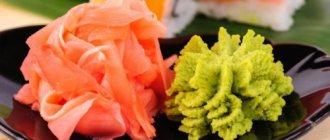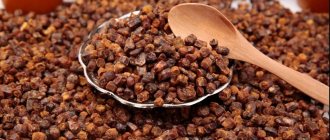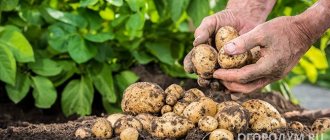Basic rules for storing peeled potatoes
It is best to use potatoes for cooking immediately after peeling them. But if for some reason you need to peel the fruits in advance and store them until use, then you need to follow several recommendations.
Let's consider the general rules for storing peeled tubers:
- It is better to store the product as a whole, without cutting it into pieces - this will allow all the beneficial substances to be retained in the fruit;
- Before storing, the fruits must be rinsed well in water;
- if the fruits are stored in a container with water, then for a better effect you can put a piece of lemon or a little citric acid in it;
- if you use a freezer for storage, then you need to portion the fruit into bags, since it can no longer be frozen again;
- Before using fruits that have been stored peeled, they must be thoroughly rinsed with water.
Did you know? Potatoes grown in 2010 in Nottinghamshire entered the Guinness Book of Records.
The tuber weighed as much as 3.8 kg!
How to store boiled and stewed potatoes
All dishes containing potatoes have a certain expiration date prescribed by sanitary standards. Public catering points are required to comply with storage rules:
- boiled potatoes,
- stewed,
- mashed potatoes,
- baked goods stuffed with potatoes.
Such dishes will remain suitable for consumption only for 18 hours. But when potato dishes are prepared at home, these standards are most often not observed.
- Storing boiled potatoes (with partial loss of taste) is possible for 8 hours without refrigeration and 24 - 36 hours in a cold place.
- Stewed potatoes should be immediately refrigerated, because the sauce that is present in this dish turns sour first.
- Potatoes boiled “in their jackets” can be stored for up to 24 hours at +20°C -+25°C or in the cold for up to 3 – 4 days.
Terms and storage time
When peeled tubers come into contact with air, they quickly become covered with a dark coating. This occurs as a result of contact of iron, magnesium and potassium contained in the fruits with oxygen. A chemical oxidation reaction begins, the vegetable quickly turns black and spoils.
To extend the shelf life of peeled vegetables for consumption, various methods are used.
Let's consider how long peeled fruits can be stored at different temperatures:
- at room temperature, the tubers can be kept in cold water for 3–4 hours, after which they lose most of the nutrients, and the taste of the fruit deteriorates;
- blanched or fresh tubers packed in a bag can be stored in the refrigerator until the next day;
- peeled fruits, soaked in water and refrigerated, can be stored for about 24 hours;
- in the freezer at temperatures down to –18°C, the fruits can remain fresh for several days;
- In a freezer at a temperature of at least –30 °C, peeled vegetables can last for several days or even weeks.
Important! When deep freezing, it is recommended to place the washed, peeled potatoes on a flat surface without wrapping them in a bag or film.
Why do peeled potatoes darken and lose their taste?
Tubers always darken after cleaning. This happens for the following reasons:
- Raw potatoes contain sugar (about 0.9%). When interacting with amino acids (enzymes), they are destroyed, and a change in organoleptic properties occurs: taste, color, smell. Therefore, the less sugar in the tubers, the longer the potatoes will be stored.
- Potatoes also contain microelements - iron, calcium, magnesium, potassium, sodium, etc. When they interact with oxygen, an oxidation reaction occurs, the product gradually turns black and loses its taste. If you block the access of oxygen, the process slows down.
There are several ways to slow down blackening and deterioration. Some of them are acceptable only in large industries, while others can be used in a regular kitchen.
Find out how to store potato supplies in winter in a cellar, apartment, or in the ground.
Potato storage methods
In order to preserve the peeled fruits and use them for the next cooking, you should prevent the appearance of black plaque on the surface of the tubers. At the same time, it is necessary that the product does not lose the beneficial substances it contains and retains its good taste. Next, we will look at methods for storing peeled potatoes at home.
At room temperature
The most popular way to store peeled potatoes at home at room temperature is to soak them in clean cold water. But this method is effective only if you need to preserve the tubers for a short period of time.
In order to prevent contact of the fetus with oxygen and slow down oxidation, perform the following actions:
- Rinse the peeled fruits in running water.
- Place the tubers in a separate capacious container (saucepan or deep bowl).
- Pour clean cold water over the vegetable so that it completely covers the tubers. You can add a raw onion or a slice of lemon.
- Cover the container with a lid, leaving a small gap for air access.
After just 48 hours of storing peeled tubers in water at room temperature, a slippery coating appears on them, indicating spoilage of the product.
In a refrigerator
If you need to save peeled potatoes until tomorrow, you can use the refrigerator. The air temperature inside should be no more than +6°C.
Did you know? The world's most expensive potato variety
-
La Bonnotte. It is grown on the French island of Noirmoutier and sells for about 500 euros per 1 kg. Depending on what dishes the product will be used for, storage in the refrigerator is carried out in different ways:
- Place the peeled tubers in a container with cold water and then put it in the refrigerator - this method is the simplest, and the fruits can later be used to prepare any dishes.
- Blanching tubers - whole vegetables are immersed in a pan of boiling water for a few seconds, and then put in a bag and placed in the refrigerator. Hot water destroys the enzymes found in the top layer of the fruit, making them unable to react with oxygen. Blanched potatoes last longer than fresh ones, but have a specific taste and can only be used for boiling in their entirety.
- Storing peeled potatoes in a tightly tied bag, from which the air has previously been released . With this method, the fruits can be used to prepare any dishes.
- Grate the tubers and add finely chopped onion or garlic to the mixture. A container with such a semi-finished product can be kept in the refrigerator under cling film and used for preparing grated potato dishes.
In the freezer
The most reliable method for keeping peeled tubers fresh and tasty for a long time is freezing the fruit. It is best to freeze potatoes whole. But if you need to use chopped tubers for preparing dishes, then they are cut in advance into pieces of the required size and only then sent to the freezer.
In order to freeze whole peeled potatoes, you need to follow these steps:
- Rinse the fruits and dry them a little with a napkin.
- Place the tubers in a plastic bag, dividing them into portions.
- Release excess air from the bag and seal it tightly.
- Place packaged portions in the freezer.
In this way, you can store potatoes that you plan to use whole for cooking in the future—the frozen fruits just need to be immersed in boiling water and boiled until tender.
Important! If tubers are stored in the freezer for a long time, they can completely lose their taste.
Freezing potatoes cut into pieces is carried out in this way:
- Rinse the tubers under running water, blot their surface with a napkin to remove excess moisture.
- Cut the fruits into pieces of the required size.
- Divide the chopped vegetables into individual portions and wrap each of them in several layers of cling film.
- Place the tubers in the freezer.
When using this storage method, you need to take into account that in the freezer the starch in potatoes turns into sugar, so the defrosted vegetable will have a sweetish taste.
scalding
You can preserve peeled potatoes in the open air for 6 hours by scalding them with a very hot liquid. Thanks to this method, the shelf life of root crops increases. At the same time, they will not deteriorate and darken at room temperature.
Until the next cooking, the tubers will not spoil, but the taste will change slightly. The product must be stored in the refrigerator compartment, first immersed in cold liquid. In this case, potatoes must be kept in a container with an airtight lid.
How to determine the suitability of potatoes
Having used one of the listed methods for storing peeled potatoes, before using them you need to check whether the tubers have deteriorated in order to understand whether they can be used for cooking.
To do this, evaluate the appearance of the potato and judge its suitability for food based on the following characteristics:
- if the potatoes were stored in a container with cold water, and it was filled with air bubbles, this signals the beginning of fermentation, and such fruits should not be eaten;
- If, when storing tubers in water, they were not completely immersed in it, then a dark coating may appear on the part of the fruit protruding from the water. Blackened areas can be cut off with a knife and after washing the vegetable in water, use it for cooking;
- if the water in which the tubers were stored becomes cloudy, this only indicates the release of starch. Such potatoes can be safely used for cooking, but they become harder and boil less well;
- the appearance of an unpleasant odor or a slippery coating on the surface of the fruits indicates that they have deteriorated. The plaque can be cut off with a knife and after washing the fruits, you can use them for food, but their taste will become worse;
- If the tubers become soft, it means they have gone bad. These potatoes should be thrown away.
Find out also how to properly and what is the best way to store potatoes on the balcony.
The most delicious dishes come from potatoes that have been peeled immediately before cooking. But if for some reason you need to prepare tubers in advance, you can do this using the above tips and recommendations. In this case, the main condition is to correctly observe the product storage conditions and terms.
Storage in water
You can store peeled potatoes in water, thanks to which the root vegetables will not darken and spoil over a long period of time. At room temperature the shelf life is approximately 4 hours. When kept in a refrigerated compartment at +5 ℃, the product will be edible within 24 hours.
How to preserve peeled potatoes - for a short period this can be done in water.
Recommendations for storing root vegetables in water:
- the liquid must be cold and not dirty;
- for soaking, you can use boiled, spring or tap liquid;
- potato tubers must be completely covered with water;
- for cooking, it is better to use the water in which the product was contained;
- Unlike a chopped product, whole tubers retain more useful components.
When storing vegetables at room temperature, they should not be exposed to direct sunlight. The place must be cool and dark.
The method of storing potatoes in water has both positive and negative sides:
| Advantages | Flaws |
| · Tubers do not need to be wrapped in film and finely chopped. · The product does not have to be kept in the refrigerator compartment. · You can easily determine the spoilage of vegetables, since bubbles appear on the surface of the water, a black coating forms on the tubers and there is an unpleasant odor. | · Characterized by a short shelf life. · Compliance with all necessary conditions does not guarantee that the product will not deteriorate. |
Have you wondered how to remove insects from cauliflower?
To remove insects from fresh cauliflower , soak it in heavily salted water for 15 minutes. The insects will float up, the cabbage will be clean.
Sauerkraut juice can be used as a salad dressing instead of vinegar.
To remove the unpleasant odor when cooking cabbage , cover the pan with gauze soaked in vinegar.
To prevent the skin of your hands from darkening when peeling young potatoes, soak them in a weak solution of table vinegar.
Potatoes can be cooked in a steamer. It will be more useful.
To make potatoes for salads light, add 1 tablespoon of vinegar to the water during cooking.
Frozen potatoes are thawed in cold salted water. The water should be changed several times.
Check out the recipe for Siberian Potatoes with Mushrooms. Highly recommended!
To keep fresh cucumbers for a long time, place them in a clean, dry enamel pan. Place the pan on the bottom shelf of the refrigerator. Do not cover with a lid.
For pickling, it is better to take small, smooth cucumbers with pimples.
When pickled and pickled, cucumbers will retain their bright green color if you first pour boiling water over them.
Pickled cucumbers will not become moldy if they are salted with chopped horseradish root or its leaves.
Pickled cucumbers or zucchini should not be served whole. It is better to cut into circles or oblong strips.
If fresh cucumbers are bitter, then they should be soaked for 10 minutes in cool milk.
A burst tomato will be preserved and will not become moldy if you sprinkle the crack with salt.
To make the radishes juicier, keep them in ice water for 5-10 minutes.
To prevent the radishes from wilting, wrap them in a wet towel and put them in the refrigerator.
To prevent turnips or radishes from becoming bitter, pour boiling water over them.
Pea pods will remain bright if they are boiled in a small amount of water.
Canned green peas for main courses should be heated with liquid and then drained.
Black radish salad will be tastier if you add fried onions to the salad.
Method 3: freezing
Step 1. Prepare the product
| |
Step 2. Packaging
| |
Step 3: Freeze Potatoes Properly
|
Common Mistakes
Root vegetables that are not properly prepared for storage can quickly spoil. Therefore, before preparing a large amount of product, it is worth making a test portion. Common problems with freezing include the following:
- the vegetable releases too much moisture;
- The potatoes are covered with an ice crust.
This indicates that the pieces were poorly dried. Before freezing, you should thoroughly blot the potatoes to remove as much liquid as possible from their surface.
There is also a risk of the following problems:
- if the potatoes turn gray in the freezer, this variety needs to be blanched;
- if the vegetable has acquired a loose texture, this indicates a high starch content - such a product must be soaked in water.
Experts advise following the rules for storing frozen vegetables. It is not recommended to defrost them again. It is important to store potatoes in separate bags, on which it is recommended to indicate the harvest date. Temperature is also of great importance.











